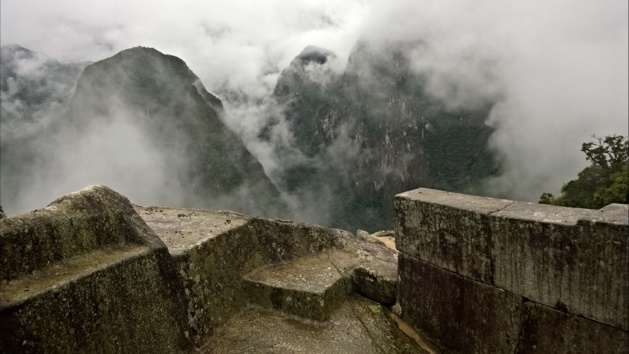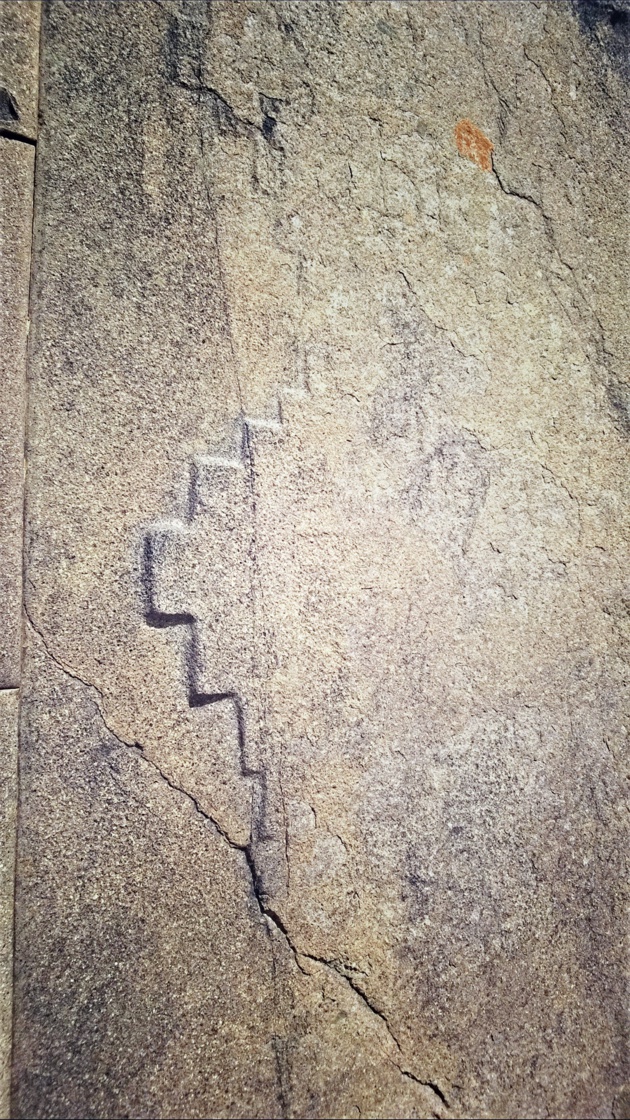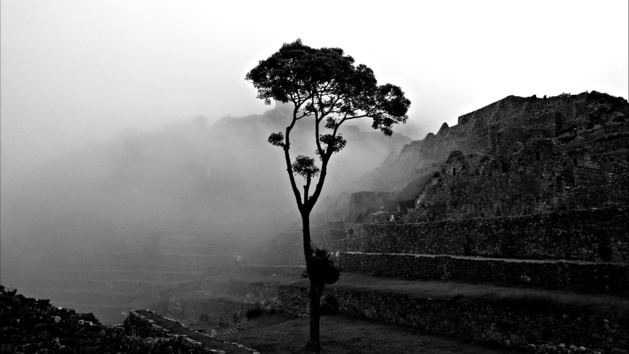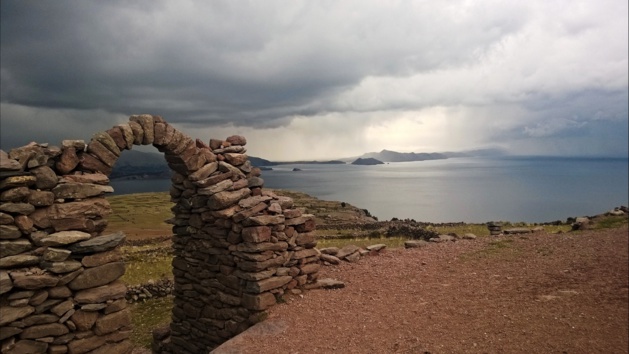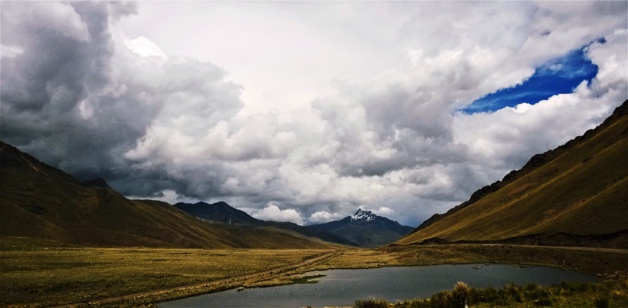After escaping three weeks of the Canadian winter I can feel the difference right after the landing in Cuzco. Not only does temperature change but my heart pumps a less oxygenated blood. The following day, I can see the difference after opening my curtains. At that point you forget about your breath. Surrounded by mountains, the city grows within their curves. It also adapts to the Inca ruins, proud of their weight which should be calculated in tons. There are two-story-high walls over the perfect puzzle of the Inca stones which were nearly impossible for the settlers of the 16th century to break. Despite the alliance of the Spanish and Pre-Colombian influences that can be seen all around the city, a third dimension exists today, tourism. The importance of weapons is the most noticeable aspect of tourism.
The city is quite international; it has a bunch of companies that still needs to respect some notification standards. The famous McDonald’s is therefore advertised with a simple and discreet black M. Anyway, I found out that there is no need for fast-food because Peru is filled with culinary delights. It is a pleasure for the food lovers, the gourmets and the gluttons who will appreciate the prices, very cheap for Europeans.
Coca is one of Peru’s riches, and is also a great ally against altitude sickness. Every day for breakfast you get a coca maté and it’s a symbol. Each day has its little fights. If during a routine control at the airport you are caught with coca tea (Are you out of your mind?!), you are likely going to experience what happened to the tourists in Geneva. Coca has a terribly bad image and if you carry some it will be destroyed, you will get a fine and maybe have to pass a urine test. Let’s keep in mind that the only legal importer in USA is Coca Cola. Also notice that coca leaf alone cannot be considered as a drug. It has properties just like everything nature produces, it provides the same effects that the fresh mint infusion from my mother’s garden in Bresse. But as it is used in the production of cocaine, this poor little plant got a criminal status, rejected by everybody which is pretty hypocritical considering that it is part of the most-drunk soda in the world.
My body is getting used to the 3400-meters altitude (thanks to the coca?), and I can now explore every street. Here you don’t look for something, you let things happen. Take a cab, explore the one-way paved streets, dusty despite the rainy season and don’t mind the driver’s impetuous and disrespectful driving. Forget about the (rare) traffic lights or the courtesy to let a stroller cross the street. About that, there are few strollers because of the ridiculous width of the sidewalks. The horns are thus a major sound in the city’s environment and in the end you get used to it. It is even a little sad not to hear them after. Despite this, there are few accidents. Is it because of their amazing reactivity using the brake and gas pedal without caring about wasting gas, or because of all the religious representations in all the cabs ? It remains a mystery.
Speeding through the streets, going further and further from the city center where the tourist traps are somewhat exasperating and where the beggars asks you for aid (but not that much), you finally discover the « suburbs ». It is where the roads are not made of asphalt, where the trash is not picked up and where stray dogs are the guardians of this land that seems out of this world. However the people I met there are living a simple life far from my concerns, and they don’t seem unhappy about it. Unfortunately they are also free of the problems that come with development. Development is nice in theory but it is done haphazardly without any logical order. Improving awareness and putting in place measures for waste processing that are clogging the rivers and more generally the environment are clearly not a priority for the economic and touristic development.
When we were heading for Chinchero we passed by a factory that shows how chemical fertilizers were inserted in the agriculture that was until now natural. It used to be gathered by hand by labourers working with cows and mules that we can see along the roads. Even if I see a flashy green John Deere in a village in the middle of nowhere, tractors are still sparse because of their expensive price. Right behind tourism, agriculture and miningare the spearhead of the Peruvian economy. Cuzco allows you to observe that odd blending between ancient civilizations, tourists, locals, rural communities, nature and development. It is a city that never shuts off, focusing on the past and does not worry much about tomorrow. The city is witness to the weaknesses of development postponing the problems that will need to be dealt with eventually.
The sacred Valley is steeped in history and mysteries
If you move off Cuzco you will find new stories but also new landscapes. All along the sacred Valley there are several stops to enjoy. The Inca experimental agronomical center of Moray mocks classic agriculture, with its circular terraces showing us a time when agronomic research was booming, searching for optimum temperatures for different cultures like corn, potatoes and cereals. Not far from there you can visit the salt pans of Maras which give you an incredible landscape with over 5000 pools on the mountainside where water charges itself with salt before flowing into those salt pans. Chinchero gives us the opportunity to discover the manufacture of textile from the cleaning of alpaca wool with a root that acts like a natural soap until the meticulous weaving and also the use of dyes all natural of course.
The dyes and symbols on the fabrics all have a very specific meaning. The black is the color of Pachamama, the mother earth that Andean cultures love so much. The symbols help us discover a world of beliefs and superstition that take over catholic symbols in the countryside. In this way you can pass by representations of the Andine Cross on ancient and recent walls together with the sacred trilogy. The snake represents the underworld, while the puma represents the reality of life on earth, and the condor rise to illustrate the celestial world, the world beyond. The rediscovery of the Temples of the Sun that are in most of the archeological cities (re)discovered allow us know the cult that was dedicated to it, the guardian of cultures.
The cities were also built according to symbolic shapes that you can only see from a certain point of view. Originally Cuzco had the shape of a puma. Upon arriving in Ollantaytambo, which looks like a corn cob, we spend our time staring up at the sky, admiring the mountains that surround us, sometimes full of ancient terraces reminding us the methods of Inca cultures, sometimes disfigured by landslides and granite quarries. In front of those is the archeological site of the city, center of the Inca resistance when the Spanish came, still dominating the Valley. This city, despite being known for being the departure point of the train to Machu Picchu, knew how to keep the charm of a city filled with history. Small stone streets that you cross with the rhythm of the music of spring water that slides down open pipe network.
However the tranquility of those streets is a little disturbed by the comings and goings of the buses, minibuses and taxis that drop tourists just like me. The horns of motorbiketaxis are not part of this disturbance because they add a faded charm to the place. I go from here to the famous UNESCO World Heritage site, Machu Picchu. It’s a 1hour and 40 minutes trip that goes through the sacred Valley, so green in summer, along the Urubamba River, foaming from the frequent rains, to the hotel restaurant station of Aguas Caliente, home of gas shuttles that connect with Machu Picchu. As the altitude gets less high, you can see a luxurious vegetation very different from the one in Cuzco, more Spartan. A lot of cactus border the fields, natural barriers used by lovers who carve their names on the leavesn just like they would put a padlock on the Lovers’ bridge in Paris (Passerelle des Arts).
Machu Picchu finally shows itself, majestic and mysterious on the mountain that bears its name. When the fog rolls in the landscape get magical which makes us step into the shoes of Hiram Binghamn who re-discovered it in 1911 when it was buried under the vegetation. Even though we can see it today, it still keep its secrets. As a symbol of the Inca civilization it is the most intriguing construction of this empire. Was it a temple? A military base? Theories are made, overturned, destroyed and reshaped. To wander in what were the streets of an Inca city gives you the strange feeling that you don‘t know, and that you may never know. When the Spanish came to Peru in the beginning of the conquest all the paths to this place were cut off. That way the Spanish never made it to this place that stayed abandoned to nature for nearly 400 years. The energy of such a place attracts tourists looking for mystical and shamanic experiences, and even some fans of photography of an inappropriate kind in such a place.
That is why you come upon a young lady very lightly dressed, with high heels, posing, posing and re-posing in front of the camera. I don’t mean to be a killjoy, but when you will go there you will understand that in this place you should forget about high heels. This place is full of surprises but is also victim of its fame. One of the “new wonders of the world », the site’s limit set by UNESCO of 2,500 visitors per day is often surpassed. The debate on tourism and its consequences can easily apply in this situation, but I can hardly criticize when I benefit from this of respect of rules. If the UNESCO setd limits they should be respected and the project to open at night should be canceled. Even if this project would reduce the number of people during the day, the installing of lights and the additional appeal that it would create would attract more people willing to see the site both during the day and at night. I am not sure that it is what the UNESCO wants.
End-of-year celebrations influenced by traditions
I went back to Cuzco for the Christmas holidays. During that period religious traditions are intensified. There is a crib in the center plaza during the market of December 24th. Everybody buys what they need for building their own crib; branches, natural foam, dyes, miniatures and of course a many people wander with a baby Jesus in their arms. The addition of Catholicism led to a weird mix by including it in the old traditions that are still in use. That mix was finally encouraged by the Spanish assimilationist methods to gain credibility with Peruvians that associated Jesus with the Sun. Eventually the two religions bounded and Catholicism took root. The same goes for the crosses on the mountains above the cities. The Apus are the gods of the mountains and were protecting the cities under them. In order to go in the mountains to honor these gods without being scolded by the priests who only cherished the Christian god, the locals built crosses in the mountains. That way the people could go honor the Apus under a catholic cross.
What is Christmas without a turkey (40lbs!) or New Year’s Eve without fireworks coming from almost every garden and balcony of the city? This could drive a firefighter mad, but also animals and children. On December 31st I came across a protest led by men, women and dogs holding signs (not the dogs) protesting against pyrotechnics. Why? Simply because a lot of dogs lose an eye, a paw, a mouth, or even dies because of those small- and sometimes big- explosives. I saw a dog, clearly stupid (like many dogs but this one especially), jumping in the middle of firecrackers thrown by children. Our guide’s dog died of a heart attack because, even if he was too smart to fetch an explosive ball, he was too fearful for his heart to withstand the noise. Well, it is sad but in the meantime seeing your first joint fireworks is wonderful. And they don’t spare any effort. It lasts an hour starting from midnight and it is worthy of our 14th of July fireworks. Another weird thing on December 31st is seeing a lot of pants on display.
You could say they are naughty but really they are mostly practical. We don’t buy them ourselves, but gentlemen, it is time to give the one you desire red underwear to wish her luck in love for the next year. Or yellow for luck, green for health (but I think we all agree that underwear is good to wish the best in love). For those less extroverted, and because we shall not give a stranger an underwear, everyone wears flower collars to grant us luck. And don’t forget to put some corn, wheat or yellow confetti in your wallets. And please, do not take it out until the next New Year’s Eve, or else… well you don’t want to know what will happen to you. These traditions may seem amusing, but are a pleasure to discover without concealing the little superstitions that we all have.
With the locals in the middle of Lake Titicaca
Speaking of beliefs, Manco Cápac and his wife/sister according to the legends came out of the lake, and then headed for Cuzco where they planted the golden stick in the middle of the “Plaza de armas”, making it the center of the world. Lake Titicaca is the highest navigable lake in the world, and is big. Very big. It is the link between Bolivia and Peru, filled with islands, mostly big and mostly floating. Aside the traditional islands are the Uros islands. Made of superimposed cut reeds, these islands float there thanks to a long pole anchored in the lake’s ground. During the 16th century, the founders hid in their boats behind reeds to escape the Spanish. They stayed there for a long time, and found out that the roots were floating, and that it was possible to build small islands. The best part of this trip was the night hosted by the locals of the Amantani Island. No electricity, no running water, no television-of course- no internet, no real insulation (it might be summer but it is not that warm). To put it in a nutshell it was the rural life punctuated by the seasons and ubiquitous agriculture. My bad Spanish level that I have been trying to improve for two weeks is no use to me since they speak Quechua. I learned a lot from such a family as warm as shy who welcomes me like this, even if it is the new trend of community tourism.
I experienced happiness and I discovered a lot of things by communicating without words with people living thousands miles away from where I live. I don’t even talk about the dance in traditional costumes in the village (I used to cry as a child when I had to dress up). You better watch your head because the door frames are very low here at 4000 meters high. After this timeless parenthesis, I went to the Taquilé Island where I discovered another patrimony protected by UNESCO (they are everywhere); fabrics that have the distinctive feature of being knitted by men.
The cultural riches were a breath of fresh air
Anyway, the visits are not the most important part of this trip. There, a trip is more of a “way of doing” than a goal; you can see it, do it, smell it, hear it, taste it and touch it. You always have to open your eyes when you pass by breathtaking landscapes during a bus trip. You would be amazed by colorful house fronts during municipal elections, by the smell of an ajji de gakkuna cooking, by the softness of an alpaca when you pet it (even if he does not care at all). Simple things that are yet so different from what I am used to. Yet when you see football goals you realize that we also share so much. The difference is in me, in the richness of the cultural diversity that I can witness on the road I wander. The bulls made out of dirt guard the houses in Pukara, the ornaments that decorate and identify the sheep in Taquilé, the traditions I witnessed in Cuzco and the Aymara language, so different from Quechua, are all symbols. Those symbols lead the manual labor of some communities, the smile of the children having fun with so few, playing hide and seek in ancient Inca ruins where in the past civilizations created with their hands the ceramics that are today locked up in display.
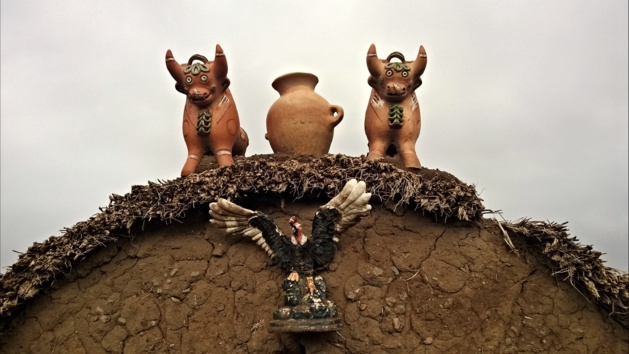
That fresh breath of life and this unpredictability were a change from my uniform and reassuring routine of my usual life environment. Every community has its own particularities. And well, the problems of this world are not a big concern to those people. You can disapprove of that, but at least they live their lives in what seemed to me a great respect of the moment. By doing this, they enjoy every day and season. Rain? It’s good for the cultures. And in the end even if rain during a trip is frustrating, it helps you learn to wait and deal with your schedule. It is also part of the experience of an unforgettable trip.
Émile Zola said: “There is no happiness in ignorance, only certitude makes life calm. ». To that we could say that giving up our certitudes and accepting our ignorance is the key to wander this earth, by enhancing ourselves with this absence of certitudes. We should always learn and discover just like we were opening our eyes for the first time.















